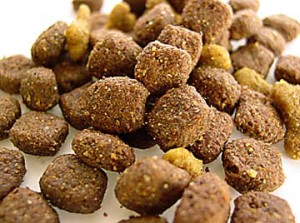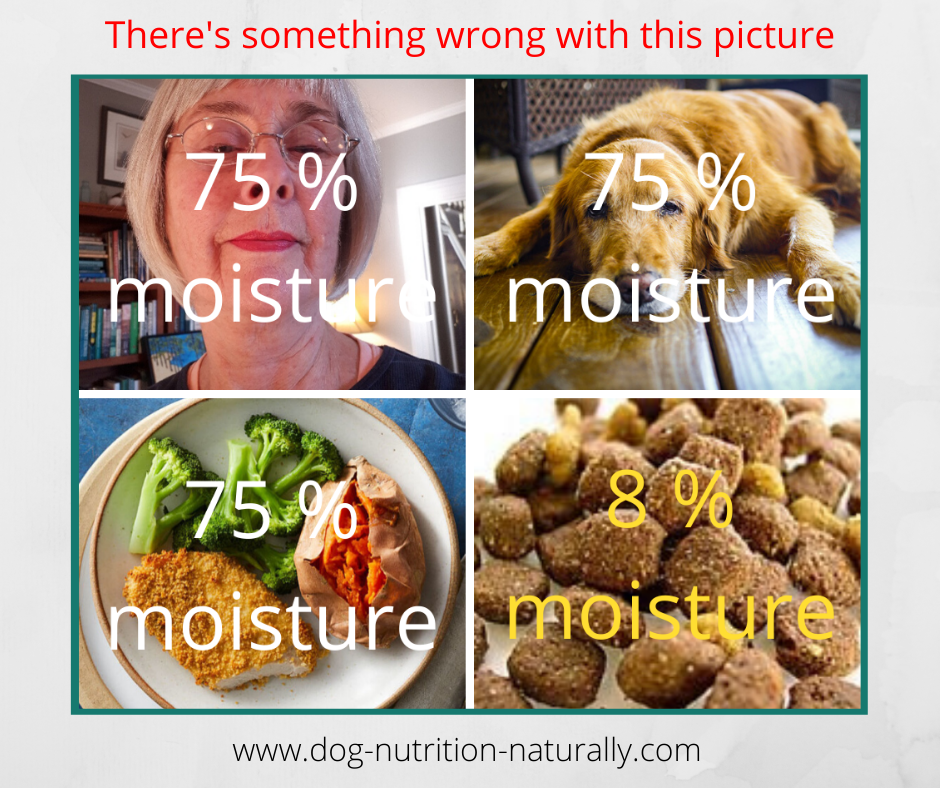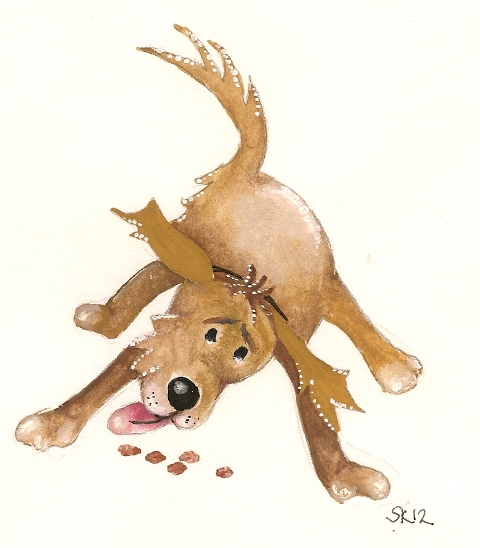Dry Dog Food
5 Important Facts to Help You Make the Best Choice
Is dry dog food your dog food of choice? Even though I'm a raw feeder, I understand that most dog owners feed commercially manufactured dog kibble. So let's face it, that's very likely you. OK, it's not a crime, and I know you're trying to do the best for your dog. I'm fine with that.
In order for you to make an informed decision about what and how to feed your dog, you need to have all the facts about what's in dry dog food, how it's made and how it affects your dog's health.

Understanding the Benefits and Disadvantages of Dry Dog Food
Without a doubt, the main reason people feed their dogs dry dog food is...convenience. It's so easy to just pour the kibble in the dog bowl and forget it. But this is of benefit to you...not your dog, and whole point of this page is to point out the benefits and risks for your dog, not you!
I am a raw feeder, but I do keep a small bag of dog kibble in the house for occasional use. It's convenient to have a good dry dog food handy in case I forget to thaw my raw, or heaven forbid, run out of raw! It gets me out of a jam.
I think of it in the same way that I might indulge myself at a convenient, fast food restaurant, occasionally. Not great food, but once in a while ( rarely ) is OK. My body can handle that, but as a steady diet, not at all. Convenience is really the ONLY major advantage worth talking about in defense of dry dog food.
Having said that, these days, there are some dry dog food manufacturers who actually put great effort into formulating a good quality kibble. Some commercial dry dog food is pretty darn good. Not as good as raw of course, but as good as it gets.
If you have time, and are interested enough to do the research
yourself, this dog food comparisons guide
can help you. If you simply want to cut to the chase and get right
down to choosing the best high quality dry dog food, let me help you save time.
Now, let's look at the 5 main disadvantages of most dry dog food so you can get both sides of the story. Read on.
#1 - The Dangers of High Heat
Processed Dog Food
Dry dog food is dead. It's dead because it's been cooked for too long using high heat temperatures which destroy nutrients and flavor. This part of the process is called rendering, which is meant to kill harmful bacteria. It does kill harmful bacteria, but it also leaves the food nutrient deficient and without flavor, so synthetic nutrients must be added back in, along with chemical flavor enhancers.
Then the rendered and flavor fortified dog food ingredients are squeezed through an extruder machine, which extracts all the moisture, in order to make those cute little dog kibbles. Those kibble shapes are not found anywhere in nature. Do you see dog kibbles growing on vines or trees, anywhere? No. They are only found in bags and boxes.
So you see it doesn't matter if the dog food ingredients are excellent to start with, human grade, organic, all natural, or whatever. The food is dead by the time it reaches your dog's bowl. The food has been ruined and nutrients have been killed from the heat of processing.
When food is heated, the natural chemical composition of the raw ingredients change, and those chemical changes are not always for the good and some are downright toxic.
You can read about the list of toxins, and toxins created from heating food at high temperatures. No wonder that cancer is on the rise in people and animals. In fact cancer is the # 1 killer of dogs today, not to mention any number of other degenerative dog health problems and other diseases.
Human beings are the only creatures on the face of the earth that cook food. What? Where the heck did we get the idea that cooked food for dogs is a good idea? To be fair, it's OK if it's not cooked at temperatures higher than 118 degrees Fahrenheit. That's enough heat to kill most harmful bacteria and other pathogens.
So in the case of our pet dogs, it is important to realize that no cooked food is perfect, and fit to be fed exclusively, everyday for years on end. Think of your own cooked diet. You eat different foods every day, including some raw food, don't you? Well your dog needs variety and fresh food too!
# 2 - Starches and Grains in Dry Dog Food
In order to make dry dog food, something is needed to make those little kibbles hold together. That something is almost always:
- grains such as wheat, corn, rice, barley, oats
- starches such as potato, sweet potato, tapioca from cassava root
- legumes such as soy beans, peas, lentils, kidney beans
Truthfully though, you don't want any of those things. These dog food ingredients are used to bind the food together, into little kibble shapes, and reduce the production cost of manufacturing. They will also add some nutrients and low quality fiber that is then broken down by the body and converted into other chemicals which are not naturally good for your pet carnivore.
Dogs are carnivores. I know you wouldn't have gotten this far without realizing by now, that dogs need a meat based diet, high in protein and fats and low in starches and carbohydrates ( fruits, vegetables, grains, legumes ) to thrive.
There's no real point in talking about the good dog food ingredients, such as protein from meat and other healthy protein sources, along with macro and micro nutrients from small amounts of fruits and veggies, and adequate supplementation. Until you get rid of the starches and grains, none of it really matters.
So are you starting to get the idea that the term ' grain free ' is another fad? If there's no grains, what are they using instead? Starches, of course! So the term ' grain free ' is gimmicky marketing, because grains are simply being replaced with something else that isn't good, either.
#3 - Other Questionable Ingredients and Untrustworthy Marketing Statements
Most people are well aware that things are added to commercial pet foods that do not promote health. Such things as...
- preservatives to extend shelf life,
- colors and dyes to make the food look appealing to you, the customer.
- less than optimal sources of protein from diseased animals, unhealthy fats.
- bare minimum nutrient value
What about other suspicious statements such as...
- 100% complete ( impossible )
- balanced ( never )
- all natural ( nonsense )
- human grade ( maybe )
- gluten free ( no grains, no gluten )
- high fiber ( watch out )
- no preservatives ( it will rot on the store shelf )
- non GMO ( sure hope so! )
- hypo-allergenic ( Really? Is there any ACTUAL food in the bag? )
These terms all sound good, right? Yes, no, maybe! I'm simply asking you to become aware that marketing terms are invented to make you feel good about your purchase decision, and might make you think you're buying something that's better than it really is.
So what now?
#4 - Commercial Dry Dog Food Marketing Campaigns Are Aimed at Your Emotions
So, if you're starting to get the idea that dog food marketing might not be telling the whole truth, you'd be right to investigate further.
Pet food manufacturers are very savvy when it comes to knowing their
target market, and the target market is YOU! My comments are not in any way meant to knock all
pet food products or those selling them, but I want you to be aware
that your emotions are the target, which isn't necessarily the same as
what is good for your dog. Make sense?
#5 - Dry Dog Food is Lacking in Moisture

Dry dog food is, well...dry! All the other disadvantages aside, this is the biggest risk, in my opinion.
By very definition, dry dog food is lacking in moisture. This is NOT a good thing. Look at the picture on the left.
Your body is 75% moisture, your dog's body is 75% moisture, most of the food YOU eat is 75% moisture, a raw food diet for dogs is 75% moisture...but YOUR dog's dry food is 8% moisture. No, no, no!
A constant diet of dry dog food will create an increasing state of dehydration within your dog's body. Even if he's drinking water from his bowl ( and I bet he drinks alot, right? ) it's simply not enough water to keep him properly hydrated and help him process his food. ***See the health tip in the right side bar***. This has the potential for causing all kinds of health problems over the course of your dog's lifetime, not the least of which is kidney disease.
Is It Possible to Buy Better Dry Dog Food?
Yup, it sure is.
Considering that the little kibbles need something nutritious as well as healthful to hold them together, the use of meat concentrates and protein isolates from meat and select vegetable sources does an excellent job.
This type of excellent dog food minus the ' grains and starches ' is available to you. It will still be dry, and it won't be perfect. Mother Nature provides the only perfect food for dogs. However, if the information on this page makes sense to you, and you want to buy a better quality dog kibble than what you would normally find at the store, then read on to find out more about my favorite recommendations for the best dry dog food.
Go From Dry Dog Food Back to Feeding Dogs
New! Comments
Have your say about what you've just read here. Use the comments box below.
Sharing is appreciated!


